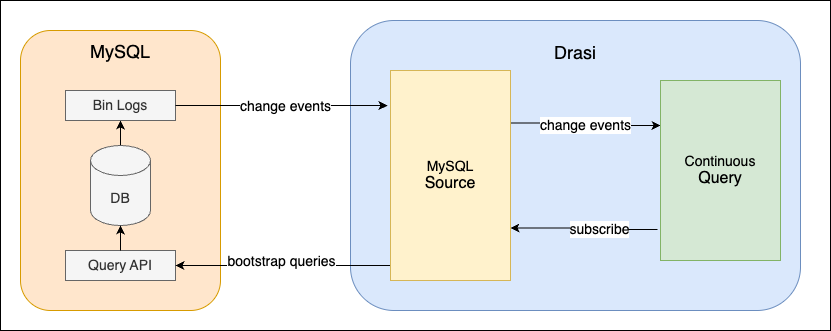Setup MySQL
Setup and Configure MySQL for Drasi
5 minute read
The MySQL Source enables Drasi connectivity to MySQL databases.

The MySQL Source translates the relational data from change events to more closely resemble property graph data change events so that they can be processed by subscribed Continuous Queries. To achieve this, it represents table rows as graph Nodes, as follows:
The MySQL Source does not interpret foreign keys or joins from the relational source, instead relying on the Source Join feature provided by Continuous Queries to mimic graph-style Relations between Nodes based on the values of specified properties. See the Source Joins topic in the Continuous Queries section for details.
To create and manage Sources using the steps described in this guide, you need the Drasi CLI installed on your computer.
The MySQL database you connect to must have binary logging enabled.
You must configure your MySQL Source with MySQL database credentials that have the necessary permissions to access the database and tables you want the Source to provide access to. Specifically, the user needs at least SELECT and REPLICATION SLAVE and REPLICATION CLIENT privileges.
See the page Setup MySQL for Drasi for assistance.
To create a MySQL Source, execute the drasi apply command as follows:
drasi apply -f my-source.yaml
The drasi apply command is how you create all new Drasi resources (in this case a Source).
The -f flag specifies that the definition of the new Source is contained in the referenced YAML file my-source.yaml.
The YAML file passed to drasi apply can contain one or more Source definitions. Here is an example of a MySQL Source definition:
apiVersion: v1
kind: Source
name: retail-ops
spec:
kind: MySQL
properties:
host: mysql.default.svc.cluster.local
port: 3306
user: mysqluser
password: secret-password
database: retail-operations
tables:
- retail-operations.Customer
- retail-operations.Sale
In this definition:
This table describes the other settings in the spec.properties section of the Source definition:
| Property | Description |
|---|---|
| host | The host name of the MySQL database server. |
| port | The port number used to communicate with the MySQL database server. |
| user | The user id to use for authentication against the MySQL database server. |
| password | The password for the user account specified in the user property. |
| database | The name of the MySQL database. |
| tables | An array of table names that the Source should process changes for. |
The example Source definition above contains plain text values for the user and password properties. This may be acceptable for its convenience during development or testing but must be avoided if the credentials need to remain secure. Instead of providing plain text values, you can configure them to use a securely stored Kubernetes Secrets as shown in the following alternate definition for the above Source:
apiVersion: v1
kind: Source
name: retail-ops
spec:
kind: MySQL
properties:
host: retail.mysql.database.azure.com
port: 3306
user:
kind: Secret
name: mysql-creds
key: user
password:
kind: Secret
name: mysql-creds
key: password
database: retail-operations
tables:
- retail-operations.Customer
- retail-operations.Sale
To create the Kubernetes Secrets used above, you would run the command:
kubectl create secret generic mysql-creds \
--from-literal=user=mysqluser \
--from-literal=password=secret-password
Currently, a Source must be fully functional with an available status of true before Continuous Queries can subscribe to it. If you create Continuous Queries that use a Source before the Source is available they will either fail, or be in an unknown state.
You can check the status of the Source using the drasi list command:
drasi list source
This will return a simple list of all Sources in the default (or specified) namespace and their overall status. For example:
ID | AVAILABLE
---------------+------------
retail-ops | true
physical-ops | false
In this case, the retail-ops Source is ready for use (AVAILABLE = true), but the physical-ops Source is not yet ready (AVAILABLE = false).
Given how important it is for Sources to be ready before you start Continuous Queries that use them, the Drasi CLI supports the ability to wait for a Source to be ready using the drasi wait command:
drasi wait source physical-ops -t 120
The drasi wait command waits for one or more resources to become operational, or for a timeout interval -t to be reached (in seconds).
If an error has occurred during the creation or operation of a Source, the AVAILABLE column will contain the error text.
For more details about a Source you can use the drasi describe command:
drasi describe source retail-ops
This will return the full definition used to create the Source along with more detailed status information.
To modify the Source, you can simply use the drasi apply command again with the same source name that you used before.
To delete a Source you use the drasi delete command. There are two ways to do this.
Firstly, you can specify the type of resource (Source) and its name, for example:
drasi delete source retail-ops
Secondly, you can refer to the YAML file(s) that contain the definitions used to create the Source(s):
drasi delete -f my-source.yaml <file2.yaml> <file3.yaml> <...>
This is a convenience, especially if a single YAML file contains multiple Source definitions.
If the Source is not in the default Drasi namespace, you should specific the target namespace using the -n flag as usual:
drasi delete -f my-source.yaml -n drasi-namespace
Note: Drasi does not currently verify or protect dependencies between Sources and the Continuous Queries that subscribe to them. It is possible to delete a Source that is actively used by one or more Continuous Queries. This will break the Continuous Queries or leave them in an unknown state.
Setup and Configure MySQL for Drasi
Was this page helpful?
Glad to hear it! Please tell us what you found helpful.
Sorry to hear that. Please tell us how we can improve.